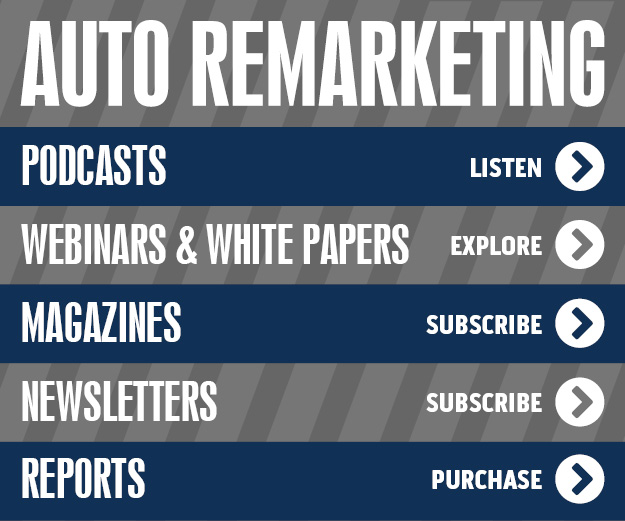NADA Used Car Guide: Despite Month-over-Month Softness, Overall Strength in Used Prices Continue
McLEAN, Va. — While the overall state of used-vehicle pricing was still rather healthy, there were numerous month-over-month value declines across various segments during June, some more pronounced than others, according to NADA Used Car Guide.
Among two- and three-year-old vehicles, the bulk of the segments were down modestly, but the one-year-old vehicle class was down sharply from earlier months. As most know, daily rental returns largely compose the one-year-old age category.
As far as the four- and five-year-old vehicles, these had increased consistently during 2010, but they started a decline, as well.
Referring to this particular class, Jonathan Banks, senior director of editorial and data services for NADA Used Car Guide, noted: "This was especially evident on small cars, where sale price performance has been relatively lackluster during this period of gas price stability."
There were widespread month-over-month decreases for luxury units, especially for luxury SUVs and CUVs, which were pushed down heavily, in particular, by the 12-percent month-over-month dip on the 2009 BMW X5 and the 2009 Cadillac Escalade's 7-percent dip.
Overall, though, values the used-vehicle market are still on an upward movement, Banks stressed.
"Generally speaking however, used-car prices for the year still remain positive as 2010 has shown a continuation of the huge gains witnessed during 2009, albeit in milder form," he stated.
"Benchmark indices confirm this, with Manheim's Used Vehicle Value Index reaching a record high and the BLS Used Vehicle CPI component showing positive movement every month this year," Banks continued. "We expect a pull-back on these indicators for June, but overall prices will remain strong and on average will outperform expected seasonal declines."
Looking at some year-over-year AuctionNet pricing changes, one- to five-year-old SUVs were up just less than 16 percent in June, vans climbed more than 14 percent, pickups and CUVs were both up around 10 percent and cars climbed between 4 percent and 6 percent.
As far as month-over-data changes, one- to five-year-old car prices dipped by more than 0.6 percent, CUVs were down about 0.2 percent, and SUVs jumped more than 0.2 percent in price.
Pickups (down in price) and vans (up in price) showed movements of less than 0.2 percent.
Moving on to auction sales volume, it still is sluggish for one- to five-year-old units, according to NADA Used Car Guide. Trucks, SUVs and vans are particularly slow.
Two- to four-year-old SUVS, trucks and vans were especially hampered in light of the supply dearth of these popular units. Supply of these vehicles is off from year-ago figures.
"In contrast, overall returning used supply on a month-to-month basis started an upward trend in May that will continue through July," Banks noted.
That said, for full-year 2010, total returning used supply is expected to fall about 4 percent. So, that May-to-July uptick won't likely be strong enough to cause any significant price slowdown, Banks explained.
"Notable segments to watch from a supply standpoint include the midsize CUV segment, particularly the Toyota Highlander and the Chevrolet Traverse (which has the largest year-over-year increase at ~20 percent), and the intermediate compact and intermediate mid-size segments which include high volume models like the Civic, Corolla, Focus, Malibu, Accord and Camry," Banks noted.
"Driven primarily by off-rental returns, these segments are expected to peak in used supply during August, right when manufacturers begin to start introducing incentives to clear inventory before new-model introductions," he continued.
Looking at some new-vehicle trends, softer-than-expected sales have not flooded dealers' new-vehicle inventories, as overall days supply is still at "reasonable levels," Banks noted.
What Banks said partially pushed down new-car sales in June was the lack of incentives, which deterred "many apprehensive consumers" from buying a new vehicle.
"However, the main driver is the uncertainty in the economy. The dramatic 9.8-percentage-point decline in consumer confidence during June correlates with the relatively dismal June sales and attests to increased apprehension from consumers in regards to making large purchases," he shared.
"This essentially points to the need to create more stimuli to assuage consumer fears and uncertainty and stimulate action to make a vehicle purchase," Banks added.
He continued: "Before June, the outlook was much more sanguine with demand stimulating sales in line with analyst expectations and which lead to strong transaction prices, low dealer inventories, and plans for increases in manufacturer production.
"This coupled with short supply in the used market likely would have stimulated even more price increases on used models if the job market had improved," Banks shared.
That said, this somewhat "negative news" is no reason to panic. In fact, overall economic improvement is still likely, based on what fundamental indicators suggest.
Adding some more backing to his point, Banks cited what National Automobile Dealers Association chief economist Paul Taylor emphasized in his latest Economic Update, as reported earlier in Auto Remarketing: "NADA estimates that chance [of a double-dip recession] at no more than 15 percent, versus the 85 percent probability that economic recovery continues at a modest pace.
"News on home prices stabilizing for the second quarter will help underpin car sales, since most households have most of their net assets represented by home equity," Taylor added.
Banks gave another positive point from Taylor, who said in the conclusion of his report: "As confidence improves and the staying power of economic growth becomes more evident during July, expect to see strong monthly new light vehicle sales from July through the end of the year."
Banks also pointed to the University of Michigan's Consumer Sentiment Survey. Basically, it suggests some shoppers are showing stronger demand for cars. Banks cited the survey as saying "among consumers with incomes over $75,000, buying plans for vehicles rose to their most favorable level in nearly five years … These gains were contingent on the availability of price discounts-two-thirds of high income households mentioned price discounts for vehicles and nearly half for durables."
Moreover, another positive sign was the fact that there were sequential and year-over-year gains for luxury import new-vehicle sales in June. For instance, BMW, Land Rover, Jaguar and Porsche were among the only 12 brands whose sales climbed month-over-month.
Continuing on, Banks suggests that automakers will roll out "calculated" incentives in light of June's market. The reasons for this projection are as follows: It is predicted that discounts will elicit a response from shoppers; cross-shopping has caused an upswing in competitive pressures; and dealers have light inventories.
"We do not expect blowout deals like we witnessed during the early 2000s, but instead prudent and model specific programs that will entice buyers into a new-vehicle purchase primarily in the form of lease subvention and APR programs," Banks stated.
"Further, according to CNW Research, the subprime loan approval rate has been steadily improving since the beginning of the year and FICO scores for lessees continues to decline. This indicates that there is more financing available for a larger share of consumers," he added.
In light of greater access to loans, which is stimulating an upswing in effective demand, the new- and used-vehicle markets should still generate healthy consumer interest, Banks said. After all, drivers still need to swap out their rides, and they'll do by leaning on "used vehicles at lower price points to satisfy their needs," Banks pointed out.
"Overall we expect the correction in June to be short lived and we should move back to very mild depreciation on used prices for the remainder of the year," he added.


